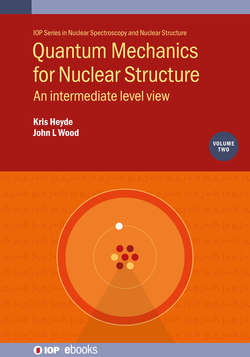Читать книгу Quantum Mechanics for Nuclear Structure, Volume 2 - Professor Kris Heyde - Страница 6
На сайте Литреса книга снята с продажи.
Preface
ОглавлениеThis book, the second in a two-part work, deals with topics that are essential for a mastery of the quantum mechanics underlying the nuclear many-body problem. These topics represent what can fairly be described as ‘an intermediate level view’, and so we adopted this subtitle. There are also some more specialised topics that we have selected because it is our opinion that they are important for handling the emerging view of the quantum mechanics needed to understand nuclei.
We begin with a thorough treatment of angular momentum theory, handled in three chapters. First, we present representations of rotations, angular momentum, and spin. This is manifested in all of their popular guises; and in some less familiar ones such as Bargmann representations. Implicit in our treatment is the need to think in terms of representations that have a tensor structure: we note such structures where they appear; but these structures play a much more important role than just their manifestation in the handling of angular momentum and spin. We continue with the details of the coupling of spins and angular momenta. The techniques are fundamental to handling finite many-body quantum systems. The Clebsch–Gordan coefficients that are encountered here are an essential topic that must be mastered by a researcher in nuclear structure, whether theorist or experimentalist. We give a brief introduction to ‘recoupling’ coefficients, 6-j and 9-j symbols. The manipulation of recoupling is straightforward but takes practice to achieve mastery: that is left for our more advanced reader to take up at a later stage in the series. We complete the angular momentum topics with details of vector and tensor operators. This is also a topic that must be mastered by the nuclear structure researcher, such that they have a clear appreciation of the power of the Wigner–Eckart theorem.
The focus then turns to identical particles and the representation of many-body states and operators. A heavy emphasis is placed on second quantization or the occupation number representation. We pay particular attention to how this language can be used to formulate solvable models of systems with correlations. Such systems exhibit properties that lie completely outside of any classical mechanical concepts. The quasi-spin formalism is a powerful language for the description of many-fermion systems that form Cooper pairs and is developed in detail. We also introduce the Lipkin model: this is a ‘toy’ model, i.e. it is not realised in nature (it is too simple). But it is exactly solvable and so can be used to test many-body approximation methods. Many-body approximations such as Hartree–Fock theory will be handled later in the series.
We then turn to the role of group theory and of algebraic structures in quantum mechanics. These two topics are closely related in quantum mechanics because of the close relationship between Lie groups and Lie algebras. We give a basic introduction to these topics, using what has been learned via angular momentum theory. We particularly emphasize the role that groups and algebras play in quantum mechanics, both as a way to a deeper understanding of the subject and as a set of tools for formulating models. We provide an introduction to Young diagrams and their manipulation. We take a few steps into the Cartan theory of Lie algebras, sufficient to acquire a deeper appreciation for the mathematics behind their application to quantum systems, especially ladder operators and spectrum generating algebras.
We complete the volume with standard treatments of perturbation theory, the variational method, and a brief handling of the quantization of the electromagnetic field and its interactions with matter.
We have aimed to focus on the quantum mechanics needed for taking up research into the nuclear many-body problem, without going into the details of nuclear modelling and approximation methods. These require familiarity with nuclear data and transformation processes, which adds another ‘dimension’ to the path to mastery of the subject. These steps will be taken later in the series.
